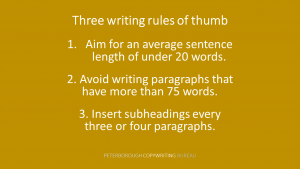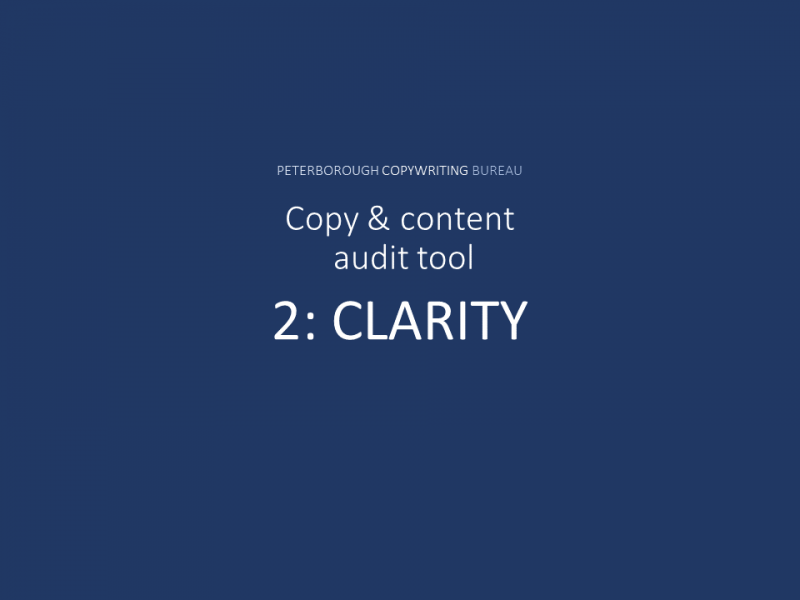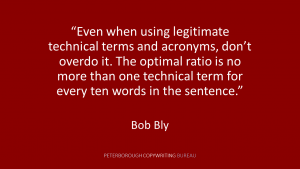Tips for assessing how clear and understandable a piece of content is, continuing my ten-part copy and content audit.
It’s amazing how often something that the writer thought was very clear looks less clear when looked at again a while later. There’s something about coming back to a piece some time later that gives us a different perspective on its clarity.
NOTE: This is part 2 in a ten-part serialisation of my eBook. Please read the introduction first if you are new to the tool.
Read it properly
We often just skim through a piece of writing, missing out words or phrases and trusting our brain to fill in the blanks. You want to avoid that here. Now is the time to read the content properly. Every word, every sentence, every paragraph. Be very tough on the content. If there is anything you don’t completely understand the first time you read it, it needs attention.

Read it out loud
When you read something out loud you perceive it in a different way. You’re more likely to spot any problems with clarity. If you find yourself stumbling over parts of the content, it’s an indication that there’s a problem.
Think like the reader
Again, be very tough on the content here. Look out for any word, phrase, sentence or paragraph that may be confusing to readers. Pay special attention to whether any abbreviations or industry jargon you’ve used will be understood by everyone the piece is aimed at.
A definition of jargon is ‘special words or expressions used by a profession or group that are difficult for others to understand’. But the problem with that definition is that it assumes everyone in a profession or group has the same level of knowledge and familiarity with jargon. That’s an unlikely scenario.
As an example, these words all relate to search engine optimisation:
-
Do Know Go.
-
Fat head.
-
Knowledge graph.
-
AMP.
-
Hummingbird.
-
Favicon.
-
Pigeon.
Even someone involved in digital marketing might not know what all these words mean. Just because someone is in your industry doesn’t mean they ‘get’ all the jargon. You will need to decide whether your content contains abbreviations and jargon likely to confuse them.
Finally, consider this excellent advice from master copywriter, Bob Bly: “Even when using legitimate technical terms and acronyms, don’t overdo it. A sentence packed with too many acronyms and technical terms seems cold, inhuman, and almost unreadable. The optimal ratio is no more than one technical term for every ten words in the sentence.”
Some solutions to ‘clarity’ problems
I’ve outlined three options below, but in fact you might use a combination of one, two or all three of them depending on the situation.
Option 1: remove some words
You can often simply remove any badly written phrase or sentence. In many cases, removal is enough, and little or no editing of what’s left is needed. Look at this example from a TV manufacturer:
Bring home a more immersive and spectacular 3D experience. With Full HD 3D, your 3D home entertainment will be more exciting and vivid than you had imagined, with powerful features to maximise your enjoyment. Thanks to 3D Auto Contrast, you’ll have a crisper image with sharper and more dramatic contrast. Samsung’s superior 3D technology uses sophisticated algorithms to minimise image layers and maximise response speed, for more fluid and clear viewing. Make sure you immerse your senses in a new reality of 3D HD.
I have worked in this sector and even I don’t know what it all means. Let’s remove the worst offending sentence and it’s an easier read:
Bring home a more immersive and spectacular 3D experience. With Full HD 3D, your 3D home entertainment will be more exciting and vivid than you had imagined, with powerful features to maximise your enjoyment. Thanks to 3D Auto Contrast, you’ll have a crisper image with sharper and more dramatic contrast. Make sure you immerse your senses in a new reality of 3D HD.
A more comprehensive edit would be better. But when time is short just chopping out the odd phrase or sentence can bring new clarity and life to a piece of dense, jargon-laden content. In this case, cutting one sentence got rid of nonsense about ‘image layers’, ‘response speed’ and ‘fluid viewing’.
Option 2: blitz the density
I don’t usually give any ‘rule of thumb’ advice but in this case, applying these three tips across a piece of dense content almost always improves it:
Tackle long sentences – aim for an average sentence length of under 20 words. Do it by identifying any sentences over 25 words long and see if they can be rewritten or split into two. For example, it’s easy to improve the readability of this 33-word sentence by splitting it into two:
Before:
Keeping chickens in a back garden is not something you should enter into lightly because there are many costs involved, as well as the time it takes to care for the chickens properly.
After:
Keeping chickens in a back garden is not something you should enter into lightly. There are many costs involved, as well as the time it takes to care for the chickens properly.

Fix long paragraphs – avoid writing paragraphs that have more than 75 words. An easy fix is to insert line breaks in any paragraphs longer than three or four sentences. Take on board this tip from Timothy Singleton, writing on Quora.com:
“When writing, it is generally best to write short paragraphs made up of three or four sentences (give or take) and then move to another paragraph. This allows the reader to think about and digest select bits of information at a time. This makes reading more comfortable.
“Paragraphs give the writer a way to distinguish between shifts in subject matter or different points to be made. At the same time, they allow a reader to feel they are moving along a bit more fluidly, taking in one point at a time.
“Paragraphs provide a flow. Readers can see with satisfaction that they have now finished four paragraphs. Wonderful, only four to go and I will have read all of this article.”
Brilliant writers can ignore this advice. They can blend short, medium and long paragraphs to great effect. But most people aren’t brilliant writers (I know I’m not!). For us, following the ‘no more than three or four sentences per paragraph’ approach is a good way to go.
Use subheadings – insert subheadings every three or four paragraphs. Subheadings make the content look more appealing and less daunting. They also help readers identify the main points of your piece. Readers can skip the bits that don’t interest them and move on to the good stuff. The subheadings as signposts to help them.
If in your audit you see content of more than four paragraphs without a subheading, try adding one.
Option 3: be a jargon-buster
Here’s an example of some writing with two potential problems:
BER alarms are declared when the number of errors hits a certain threshold. Depending on the threshold, there are two types of BER alarms. In both cases the interface is taken down.
The first problem is that maybe not everyone will know what BER stands for. That’s an easy fix:
Bit error rate (BER) alarms are declared when the number of errors hits a certain threshold. Depending on the threshold, there are two types of BER alarms. In both cases the interface is taken down.
The second problem is that maybe not everyone will know what a bit error rate is, so let’s add a description:
A bit error is where received bits of a data stream are altered, usually due to noise, interference or distortion. We express the bit error rate (BER) as a percentage of the number of transferred bits during a specific time interval.
Where the BER hits a certain threshold a BER alarm is declared. Depending on the threshold, there are two types of BER alarms. In both cases the interface is taken down.
Another option would be to have a glossary function on your website or in a document. Online, you can link all abbreviations and jargon to their definitions/explanations.


